Vol 2 No. 28 TROPIC LIGHTNING NEWS July 17, 1967
Index
2nd Brigade Wolfhounds Net 66 VC
1st Battalion Chases VC
The Viet Cong threw down their weapons and fled in a real running
battle with "Wolfhounds" of the 2nd Bde west of Duc Hoa.
The 1st Bn, 27th Inf, reacted immediately to an intelligence report
received at the brigade command post at Duc Hoa. It said that a platoon
sized Viet Cong unit was operating in the area.
Shortly after noon, assault helicopters of Co B led by CPT Thomas
Mannix of Dayton, Ohio, swept into the designated landing zones. They met
no enemy resistance.
Minutes later, Battalion Commander LTC Edward Peter spotted 30 Viet
Cong running from the landing zone. He ordered Co A and Co C into blocking
positions ahead of the enemy.
Soon after touching down in the knee deep swamp area, the two
companies began sweeping inward. The first to make contact was the 2nd Plt
of Co A. As they burst through a thick hedgerow they came face to face
with five VC. All five were killed in the brief firefight that followed.
The remainder of the company spotted 20 VC 100 meters to their
front and began the chase. "We chased them for almost 800 meters,"
said squad leader SGT Gerald Hudson. "We killed a few as they turned to
fire back, and then ran on after the others."
Co A killed a total of 12 enemy soldiers in the running fight and
captured five rifles. Gunships supporting the battalion accounted for an
additional nine VC. Co C killed one.
Many of the enemy soldiers threw their weapons into canals as they
ran. Captured documents indicated that they were members of a local Viet
Cong guerrilla unit.
In a separate action in the area, the Wolfhounds killed 27 Viet
Cong. The estimated platoon sized force was fighting from bunkers.
Co A, 1st Bn, 27th Inf "Wolfhounds," were airlifted into a
planned landing zone soon after noon. As they charged out of their
helicopters they were met by heavy enemy fire.
CPT Leonard Marcum, Co A commander, led an assault against the
enemy positions.
Battalion Commander LTC Harvey Perritt ordered Co B into the air to
reinforce the embattled company. The ships touched down in the midst of
the fighting.
"Firing was coming from two well protected bunkers to our
front," said CPT Larry Garlock. "It was well timed and tremendously
accurate." Within minutes, Co B was also pinned down.
According to soldiers in the company, Garlock raced across the
front encouraging the men to fire. He drew fire continually as he ran but
managed to build up return fire.
The firing drove many of the Viet Cong soldiers back, but the two
bunkers continued to hold down the two companies even though several men had
worked their way to the rear of the position.
CPT Roger Taylor, Wolfhounds headquarters company commander, who
was "just along for the ride," waited until fire was built up from the
right, and charged the bunker from the left. He fired into one of the
portholes killing a Viet Cong gunner.
Both companies then swept over the positions. In the
fighting, eight enemy soldiers were killed without a US casualty.
The routed VC platoon fled into an open field in an attempt to
escape. The supporting helicopter gunships killed 14. The 2nd Bde
command ship killed an additional four with its door guns.
The action took place as part of a series of continuing air
assaults by 2nd Bde units designed to maintain pressure on Viet Cong units in
the Operation "Kolekole" area.
2nd Battalion Blocks Enemy
A heliborne blocking force of the 25th Inf Div's 2nd Bde brought
a Viet Cong escape attempt to a dead halt recently southwest of the division's
Cu Chi base camp.
The action began when Co C of the 2nd Bn, 27th Inf
"Wolfhounds," swept into planned landing zones west of Duc Hoa. As the
ships touched down an estimated Viet Cong platoon opened up. Co C returned
fire and drove the Viet Cong into a running retreat.
The blocking force made up of Co A and Co B of the battalion were
airlifted into positions in front of the enemy.
Viet Cong snipers began firing into Co B as soon as they landed.
The unit returned fire and assaulted, killing two enemy soldiers.
Sweeping ahead, they killed two more and captured an automatic
rifle. Snipers once again began firing. This time two VC were killed
in the assault that followed and a carbine rifle was captured.
The enemy refused to quit as another sniper opened up when the
company began its move back to the landing zone. In a maneuver they were
familiar with by then, the unit assaulted and killed the sniper, taking his M-1
rifle.
Meanwhile, Co C had killed two Viet Cong, and captured one new
RPG-2 anti-tank rocket launcher. In the fight one man was killed as he
attempted to silence a VC automatic rifle, and two men were wounded.
Adding to the total for the day, Co A accounted for one VC and
supporting gunships killed two.
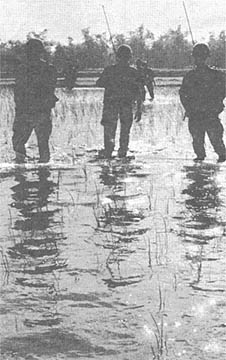 |
CPT Riley Pitts, commander of Co C, 2nd Bn, 27th Inf, and two RTO's walk through the water in a flooded rice paddy in the early morning as the company moves out during Operation "Kolekole." The "Wolfhounds" are operating west of Duc Hoa. (Photo by PFC Bruce Dapprich) |
Two Major Commands Changed
COL Leonard R. Deams Jr., has replaced COL Edwin W. Emerson as the
head of Support Command. COL Emerson has taken over as head of the 2nd Bde,
replacing COL Marvin D. Fuller who is assigned to G-3, II Field Force.
Deams of Butte, Mont., was previously chief of staff of
Headquarters Detachment, United States Army Signal Corps, Cam Ranh Bay.
During his military career, Deams has served in Luzon and in the
Korean War. Among his awards are the Bronze Star with oak leaf cluster,
Legion of Merit, and Combat Infantry Badge. COL Deams received his bachelor of science degree from
Montana State University. He has also attended the Command and General Staff College at
Ft Leavenworth, Kan., and the Air University at Maxwell AFB, Fla.
Former commander of Support Command, COL Emerson, of Deland, Fla.,
was assigned prior to his coming to Vietnam to the Chief Tactical Operations
Center at Ft Benning, Ga. He has also served in Leyte, Okinawa, and in
Korea during World War II, with three additional tours in Korea since 1947.
His awards include the Bronze Star for Valor with oak leaf cluster,
the Army Commendation Medal, Air Medal, Purple Heart and Combat Infantry Badge.
Emerson is a graduate of Montana State University and George
Washington University. He has attended the Command and General Staff
College and the U.S. Army War College, both at Ft Leavenworth, Kan.
Three hours after assuming command, COL Emerson was credited with
killing four Communist guerrillas from his helicopter while flying over the
brigade's operational area near Duc Hoa.
Full-brim Hat
Army's Chief of Staff has approved a tropical full-brim combat
hat for Southeast Asia replacing the "baseball cap."
The new hat, which provides increased sun and rain protection, will
start coming off production lines sometime after August.
| The presentation of the colors and color guard to GEN Tillson and GEN Palmer of July 4th ceremonies at division quadrangle. (Photo by SFC Roy Doupe) | 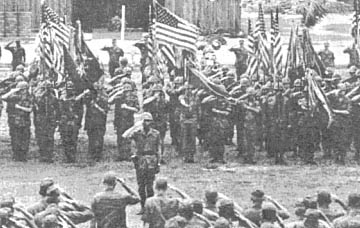 |
Page 2 TROPIC LIGHTNING NEWS July 17, 1967
Decorated
| SILVER STAR | |
|
LTC Stephen E. Nichols, HHC, 2nd Bn, 1st Inf, 196 Lt Inf
Bde LTC Harvey H. Perritt, HHC, 1st Bn, 27th Inf CPT Thomas B. Mannix, Co B, 2nd Bn, 27th Inf CPT Leonard G. Marcum, Co A, 1st Bn, 27th Inf CPT Leon R. Mayer, Co B, 2nd Bn, 12th Inf CPT Jerry 0. Parrish, Co C, 1st Bn, 27th Inf CPT John C. Trammell, Co C, 4th Bn (Mech), 23d Inf 1LT Charles R. Blackburn, Co A, 4th Bn (Mech), 23d Inf PSF Wade A. Durham, Co A, 2nd Bn, 27th Inf SSG Robert H. Blackwell, HHC, 1st Bn, 27th Inf SSG Heinz G. Janthor, Co B, 2nd Bn, 27th Inf |
SSG Richard C. Johnson, Co C, 2nd Bn, lst Inf, 196 Lt Inf Bde SSG Jessie J. Robinson, B Btry, 2nd Bn, 77th Arty SP5 Norman L. Ballance III HHB, 2nd Bn, 77th Arty SP5 Willie H. Brown, HHC, 1st Bn, 27th Inf SGT Gary L. Hipp, Co A, 2nd Bn, 12th Inf SGT Harry W. Rinker, Co C, 1st Bn, 27th Inf SP4 Gary L. Nott, Co B, 2nd Bn, 27th Inf SP4 Michael D. Woods, Co B, 1st Bn, 27th Inf PFC Daniel A. Rouseau, HHC 1st Bn, 27th Inf PVT Edward M Beasley, Co C, 2nd Bn, 14th Inf |
| BRONZE STAR (VALOR) |
|
|
MAJ Donald L. Galgano, HH&S Btry, 2nd Bn, 77th Arty CPT David E. Cooper, Co A, 2nd Bn, 27th Inf CPT Don L. Holland, Co B, 4th Bn (Mech), 23 Inf SSG Sammy D. Kay Jr, Co C, 2nd Bn (Mech), 22nd Inf SGT Jesus M. Garcia, Co B, 1st Bn, 27th Inf SP4 Kenneth A. Gore, Co A, 1st Bn, 27th Inf SP4 Aubrey L. Hewitt, Co A, 1st Bn, 27th Inf SP4 Clarence L. Jones, Co A, 2nd Bn, 27th Inf |
SP4 Robert L. Lawson, Co B, 1st Bn, 27th Inf SP4 Lawrence E. Pollock, B Btry, 2nd Bn, 77th Arty SP4 Arthur W. Price, Co B, 3d Bn, 22nd Inf SP4 Joseph D. Prince Jr., HHC, 1st Bn, 27th Inf PFC Edward Cibulski Jr., Co B, 3d Bn, 22nd Inf PFC Larry W. Gephart, Co A, 2nd Bn, 27th Inf PFC Richard E. Potter, HHC 2nd Bn, 14th Inf |
| BRONZE STAR (MERIT)) |
|
|
LTC Ralph W. Julian, HHC, 2nd Bn (Mech), 22nd Inf LTC John W. Vessey Jr., HHB, 25th Inf Div Arty MAJ Danny L. Romig, Co A, 25th Avn Bn, 25th Inf Div CPT John P. Fortner, 25th Admin Co, 25th Inf Div CPT Paul M Pugh, HHC, 25th Inf Div 1LT Douglas H. Hudson, 25th Admin Co, 25th Inf Div 1LT Jimmy L. Jones, HHC, 1st Bde, 25th Inf Div 1LT George P. Rogers, B Trp, 3d Sqdn, 4th Cav 1LT Freddie L. Miller, Co C, 2nd Bn, 14th Inf SSG Guillermo Gomez, Co C, 1st Bn (Mech), 5th Inf SP6 Rom Worley, HHC, 1st Bn (Mech), 5th Inf SGT Antanasio Espinosa Jr., Co A, 1st Bn (Mech), 5th Inf SGT Vincent R. Steinhart, Co A, 1st Bn (Mech), 5th Inf |
SP4 Everdene Baker Jr., Co B, 1st Bn (Mech), 5th Inf SP4 Stephen L. Colopy, Co C, 1st Bn (Mech), 5th Inf SP4 Thomas M. Curley, Co B, 4th Bn, 9th Inf SP4 Harris V. Davis, Co B, 1st Bn (Mech), 5th Inf SP4 Kenneth A. Gore, Co A, 1st Bn, 27th Inf SP4 Aubrey L. Hewitt, Co A, 1st Bn, 27th Inf SP4 Gary W. Fox, 38th Inf Plt (Sct Dog), 25th Inf Div SP4 Thomas Leatrice, Co C, 1st Bn (Mech), 5th Inf SP4 James F. McGoey, Co C, 2nd Bn, 27th Inf SP4 Teddy W. Steelmarp, HHC, 2nd Bn (Mech), 22nd Inf PFC William L. Evans, Co B, 1st Bn (Mech), 5th Inf PFC Donald L. Patterson, Co C, 1st Bn, 27th Inf |
Editorial
An American Tradition
"A free society devoted to achieving the natural rights of its
citizens can be maintained and tyranny prevented only if the people in general
are well educated." - Thomas Jefferson.
Millions of young Americans have completed another school year.
Many of them have entered the world of business or industry to apply the
knowledge they have absorbed during their years in school. The remainder
will return to their respective schools in the fall.
Whatever the case may be, these millions have reaped the benefits
of a tradition that is a vital part of our priceless heritage - the opportunity
for every American to obtain an education.
The United States has one of the most comprehensive public
education systems in the world. Our public schools, colleges and
universities, coupled with the thousands of private educational institutions,
have helped to produce an articulate and knowledgeable population.
The awareness of the value of an educated populace is no accident.
For more than 300 years education has been considered essential in America.
As early as 1642, civil authority required compulsory education of children.
Throughout our history, as our nation has progressed so has our
educational system. It has sought to provide the youth of our nation with
the skills and knowledge necessary to succeed in an increasingly competitive and
complicated society.
The methods and curricula within our educational system are
continually changing in order to meet the growing demands of our modern world.
Its ultimate goal, however, is an educated, intelligent population which can
preserve and advance our democratic society.
Yes . . but how? How can you or I receive an education,
especially if there is a shortage of funds. For the serviceman, there is
the GI Bill. There is always the possibility of a scholarship which should
be investigated carefully before complaining about lack of funds. A small
scholarship, or a part-time job coupled with the benefits of the GI Bill put a
college education within everyone's reach.
Frankly, one of the most tangible aspects of a college education is
a better job with higher pay, more earning power. The days of self-made
and self-educated men are not gone, but a good education is a certain shortcut
to success.
COL Shanahan Leaves 3rd
Bde, 25th
DUC PHO - COL James G. Shanahan, commanding officer of the 3rd Bde
Task Force, 25th Inf Div, said farewell to the officers and men of the command
in a ceremony at the Bde's Tactical Command Post recently at Duc Pho.
Shanahan has commanded the "Bronco" brigade since Oct. 20, 1966
and is leaving to assume the duties of deputy chief of staff of personnel at the
Pentagon.
The Legion of Merit (first oak leaf cluster) and the Silver Star
(first oak leaf cluster) were presented to Shanahan by MG William R. Peers, 4th
Inf Div commander.
Speaking to representatives of units within the Brigade, COL
Shanahan praised the Broncos on the enviable record they have established.
COL Shanahan is far from a stranger to the "Tropic Lightning"
Division. Twice before he has commanded units of the 25th Inf Div in
combat. In July of 1944 he was assigned to the 1st Bn, 35th Inf, serving
first as a rifle platoon leader and later a company commander.
In Korea, Shanahan commanded the 1st Bn, 38th Inf, and participated
in the Korean Summer-Fall, the 3rd Korean Winter and the Korean Summer 1953
Campaigns.
COL Shanahan's other assignments include one year as chief of the
Royal Arabian Guard in Saudi Arabia; three years as operations and training
staff officer for the U.S. Continental Army Command with the Marines at the Marine Corps School,
Quantico, Va.; three years as instructor at the Infantry School in the
Leadership and Tactics Departments; and three years in the Strategic Operations
Division, J-3, Joint Chief of Staff, Washington, D.C.
In July 1966, COL Shanahan became the deputy chief of staff of I
Field Forces, Vietnam. In September he was assigned to the Bde as the
deputy commander until taking over command on Oct. 20.
He is a graduate of the Command and General Staff College, the
Armed Forces Staff College, and the National War College.
His other decorations include: two Bronze Stars for Valor, four
Bronze Stars for Merit, Joint Service Commendation Medal, Army Commendation
Medal with oak leaf cluster, Purple Heart, Air Medal with eight clusters, Combat
Infantryman's Badge with two stars, the Vietnamese National Order of Valor and
two Vietnamese Gallantry Crosses.
COL Shanahan's wife Patricia, their daughter Kathleen, and five
sons, James, David, Mark, Edward and John, reside in Alexandria, Va.
Reserve Rules Relaxed
The Pentagon announced recently that military reservists who have
served two years' active duty generally will be exempt from the weekly drills
in the Ready Reserve.
"In no event," announced the Pentagon, "shall a man who has
served in Vietnam be involuntarily assigned to a Ready Reserve unit for purposes
of weekly drills."
The new policy may mean the release of thousands of men currently
required to attend weekly meetings of the Active Reserve or National Guard
Units.
The Army estimated that there are 25,000 men mandatorily attached
to Ready Reserve units who will be eligible for release, if they so desire, by
Dec. 1. Unspecified numbers of Navy and Air Force Reservists are also
involved.
Normally, after a man completes his two or three years' active
duty, depending on whether he was drafted or volunteered for the Army, he spends
three years in the Active Reserve or National Guard, then sits out one year of
stand-by Reserve.
This announced policy is not a blanket exemption. The
Pentagon said that some Reservists may be held in Ready Reserve units, if
"after diligent recruiting, it is determined that a vacancy cannot be
otherwise filled."
At the same time, the Pentagon said, the new policy does not mean
that men exempt from making weekly drills will not be required to attend the
usual two-week summer active duty camps.
The policy was laid down in a memorandum to the services by Deputy
Secretary of Defense, Cyrus Vance.
The TROPIC LIGHTNING NEWS is an authorized publication of the 25th Infantry Division. It is published weekly for all division units in the Republic of Vietnam by the Information Office, 25th Infantry Division, APO San Francisco 96225. Army News Features, Army Photo Features, Armed Forces Press Service and Armed Forces News Bureau material are used. Views and opinions expressed are not necessarily those of the Department of the Army. Printed in Tokyo, Japan, by Pacific Stars and Stripes.
MG John C. F. Tillson III . . . . . . . . Commanding General
MAJ Bernard S. Rhees . . . . . . . . . . Information Officer
CPT John P. Fortner . . . . . . . . . . . . Officer-in-Charge
SSG David G. Wilkinson . . . . . . . . NCOIC
SP4 Terry S. Richard . . . . . . . . . . . Editor
SP4 John R. Dittmann . . . . . . . . . . Editorial Assistant
Page 3 TROPIC LIGHTNING NEWS July 17, 1967
Artillery Harasses Local Viet Cong
Once the Viet Cong were masters of the night. The tables are
now turning and the VC are beginning to have as much to fear in the darkness as
they have to fear in the day. The object of their fears is the Harassment
and Interdiction (H&I) program carried on by the heavy artillery units of
the 25th Inf Div.
Briefly stated, this program allows the artillery units to control
vast amounts of jungle and forests that would take more than three times as many
men as are now involved. By nightly shelling of these areas the Viet Cong
are seriously hampered in their operations.
A typical unit involved in this program is Delta Btry of the 3rd Bn,
13th Arty. The heavy guns of Delta can hurl hundreds of pounds of hot
steel a mnute at the enemy. Each of the four self propelled eight inch
howitzers fire a two hundred pound projectile with a large killing radius.
The range of the eight-inch guns is further enhanced by the high
degree of mobility afforded by their tracked carriages. On a year round
basis Delta can take to the field and be supplied by truck or helicopter with
ammunition. Often a platoon is sent to one fire support base while the
remaining two guns are deployed in another firing area or stay in base camp.
Since the arrival of Delta in Vietnam in April 1966, they have
participated in seventeen operations. Among them are such noted names as:
"Attleboro, Cedar Falls, Junction City," and "Manhattan."
During these field operations they have fired direct support during
the day while continuing the H&I program at night. This provides a
heavy work load as evidenced by the nearly 6,000,000 pounds of high explosives
fired during only fifteen months of operation in Vietnam.
Cannoneer Dale M. Gerber remembers many times when the battery has
fired 400 rounds in a night's work. The gun crews pull twenty-four hour
shifts and as Gerber from Hoven, South Dakota, said; "I sure get tired during
those twenty-four hours, but if it kills Charlie I'm happy."
The Harassment and Interdiction program has a twofold purpose,
stated Delta's commanding officer CPT Curtis L. Lamm.
"With the artillery we can maintain enough control over the
free fire zones to prevent the Viet Cong from setting up any permanent bases for
operations," Lamm of Parkersburg, W.Va. explained.
The second, and most important phase of the operation is aimed at
the psychological effects produced by an artillery shell exploding in the dead
of night. The howitzers fire at known jungle trails with the hope of
hitting a Communist patrol but more important it keeps the enemy in fear of
being hit when he least expects it. Interrogation of Hoi Chanh shows that
this program is meeting with a good measure of success.
One Hoi Chanh stated about the effects of artillery: "the members
of my platoon are very much afraid of the artillery fire, even more than they
fear the B52 raids," he further emphasized.
Another returnee complained, "the fire disrupted us quite often
at night so that we had to sleep in foxholes."
Most captured VC tell of the constant terror caused by the shells
howling overhead and exploding with a tremendous roar. They are afraid to
walk the jungle trails at night and must split up into small groups and travel
long and arduous routes to reach their objective yet stay out of range of the
"Thundering Death".
Most of the "Red Legs" favor the program because as PFC Thomas
J. Fath of Markleville, Ind., said, "It keeps Charlie away from base camp and
I'm all in favor of that."
Amplified Warfare
'The Other War'
The tiny plane circled overhead while Viet Cong guerrillas crouched
under cover in the mud along the Oriental River. An eerie Vietnamese
voice floated down to the men from powerful speakers aboard the aircraft.
It told them of 34 of their fellow soldiers who had died two days
before and the 47 who had rallied to the Government side. Then the sky was
filled with white as thousands of leaflets floated to earth with maps and
directions telling the men how they too could again live a free and safe life
under the "Chieu Hoi" program.
The plane was flying the mission for the 25th Inf Div's 2nd Bde
after "Wolfhounds" of the 27th Inf had nearly destroyed a local VC unit
without taking a single friendly casualty.
Aboard the plane crowded with boxes or leaflets, high-powered
amplifiers and huge speakers rode the pilot, MAJ Robert Harper of the 15th Air
Commando Squadron at Bien Hoa, and 2LT James Jones of the Bde Civil Affairs
section.
As Harper threw the plane into a slight bank to the left to aim the
speakers downward, Jones flipped on the specially recorded Vietnamese language
tape. Then he twisted around in the tight seat and began stuffing leaflets
down the drop chute. "The loudspeaker operation is all automatic," said
Jones, "and, after you throw 150,000 leaflets down the pipe, you begin wishing
the leaflet system were automatic too."
With a speaker that can be heard clearly on the ground from 3000
feet, it must be deafening in the cockpit. "Not at all," said Jones, "the
speakers are very directional, and the roar of the engines covers up most of the
sound."
Four hours later, the ship touched down at Cu Chi with its tapes,
four large empty boxes, and one very tired lieutenant in the passenger seat. The
mission had covered the entire Oriental River area from west of Duc Hoa to Hiep
Hoa.
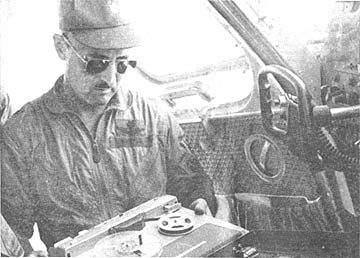 |
MAJ Harper and 2LT Jones set up the Vietnamese language tape in the cockpit before taking off from Cu Chi. This plane flew over an area along the Oriental River where the "Wolfhounds" killed 34 Viet Cong recently. (Photo by 1LT A. R. Karel) |
| THE CHUTE - More than 150,000 leaflets are stuffed through this specially constructed hatch during an average flight. The leaflets are maps showing the location of Chieu Hoi collecting points and "safe conduct" | 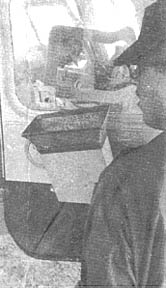 |
Luck is with Ambush Patrol On Rice Paddy Duty
CHU LAI - "I could see them coming toward our position and was
glad to know the rest of the men had also seen them." These were the
words of PFC James H. Lee of Greencastle, Ind. after a night ambush that
accounted for three dead Viet Cong.
"To us, this was just another ambush," remembers Lee, a member
of Alpha company, 3rd Bn, 21st Inf, 196th Lt Inf Bde. "We didn't
expect much excitement that night, but we sure got it.
"The patrol was all saddled up and ready to start moving to our
position by dark. Much of the movement was through rice paddies.
Rice paddies don't offer much protection, but luck was with us. Although
moving would be much harder, I was glad when we reached the woodline.
"I had not been in my position on the left flank long when I saw
five VC coming toward our right. The fireworks started when a mine was
triggered. After that the entire patrol started firing.
"The squad leader, SGT Lloyd Jones of Oakland City, Ind., ordered
us to cease fire, thinking it was all over. But only a few seconds passed
before five grenades flew into our position.
"Two of our men had received shrapnel from the grenades, so we
pulled back to a valley and bandaged them up."
The next morning a reinforced squad searched the area and found
three dead VC and a sub-machine gun. They also found about 150 rounds of
ammunition and two bangalore torpedos.
Running Water For VC
DUC PHO - While on a search and destroy mission, Co A, 1st
Bn, 35th Inf, 3rd Bde Task Force, 25th Inf Div, spotted what appeared to be two
camouflaged huts on the side of a hill. A closer investigation revealed a
large tunnel complex.
The complex was very well equipped including a bathing area, mess
hall and sleeping quarters for a company-size force.
The bathing area had running water which was piped down from the
mountains in bamboo troughs.
A unique alarm system had been constructed which could signal
intrusion from any direction. Tiny wires running to points on the
perimeter would sound a gong if tripped.
As one soldier stated, "The place must have been an R&R
center for VC."
Key To Opportunity
Education is the key that opens the door of opportunity. See
your education officer and take advantage of military education programs.
| ARMOR BORNE MILITARY POLICE - One of three newly acquired V-100 Commando armored reconnaissance vehicles, driven by personnel of the 720th Mil Police Bn, leads a 25th Inf Div convoy through the village of Cu Chi, and from there, the MPs have the additional assistance of armored personnel carriers from the 3d Sqdn, 4th Cav, the rest of the way to Tay Ninh. (Photo by SSG Raymond Levine) | 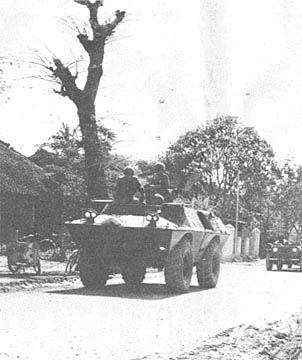 |
Page 4-5 TROPIC LIGHTNING NEWS July 17, 1967
Artillery - Precise, Controlled Destruction
|
Story and
photos |
Artillery has been a standard fixture of
armies since men first started conducting their wars in cohesive formations.
In the pre-gunpowders era, Greek and Roman artillerists used catapults and other
crude devices to bombard their enemies with large stones, incendiary materials
and, on occasion, relatives of the men fighting on the other side.
That they were effective is evidenced by the fact that damage
wrought by Roman artillery in the siege of the Palestinian fortress of Masada is
visible to this day.
With the invention of gunpowder, purportedly by a mad Bavarian monk
named Schwartz, the range, combat power and versatility of this arm came into
its own. In the Thirty Years War and the later battles of the Napoleonic
Era, Gustavus Adolphus (who was always a bit ahead of his time) and Napoleon
Bonaparte were the first to grasp the advantages inherent in mobile artillery.
Under their guidance, light, horse-drawn and easily serviced weapons replaced
the slow, cumbersome siege bombards that had spelled the end of the Feudal Era
in earlier decades. The results achieved were astounding. For the
first time sheer long range firepower played a decisive role in land combat.
The apogee of pre-atomic firepower was reached by the German
Wehrmacht in its battles on the Eastern Front in the Second World War. In
the siege of the Russian fortress of Sevastopol in late 1942, they employed the
"karl." This magnificent weapon, having a bore 31 and a half inches in
diameter, fired a concrete and steel piercing shell weighing nearly five tons.
Reports indicate that one round from this monster penetrated 100 feet of earth,
concrete and steel to destroy a Russian underground ammunition dump.
In its battles in the jungles and paddy fields of Vietnam, the U.S.
Army artillery is adding new dimensions to the effective utilization of
artillery. Fighting in a "War without Lines," our artillery has
overcome the obstacles of space and time through the use of heavily defended
Fire Support Bases and heli-mobile, sling loaded batteries.
The men depicted in the photographs below, the men of Btry A, 1st
Bn, 8th Arty, of the 25th "Tropic Lightning" Inf Div, are carrying on as
their ancestors did before them and in the same tradition, helping to write a
new chapter in the long history of artillery close combat support.
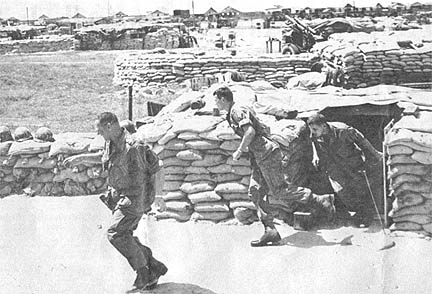 |
| WE'VE GOT A MISSION - The nine man artillery section charges from their bunker to man the gun. Fast reactions are needed; even in this war where the artillerymen are not always close to the action. |
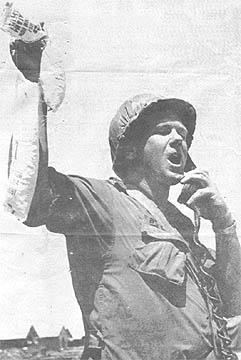 |
'CHARGE FOUR' - The section chief relays instructions to his gunners while holding unused charges. |
| NERVE CENTER - The fire direction officer checks firing data with a mechanized computer while the horizontal chart operator plots the impact point of the shells. | 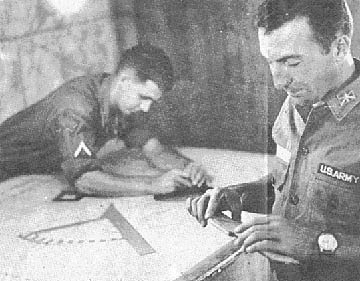 |
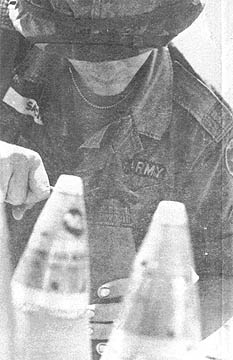 |
JUST A SLIGHT TWIST - A cannoneer sets the fuze timer on a 105 mm HE shell. |
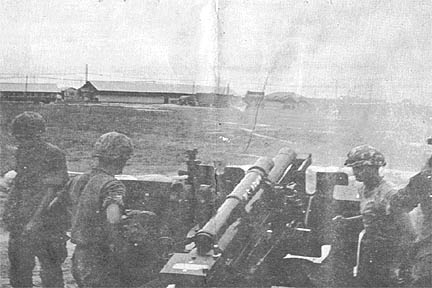 |
| SHOT OUT - The finished product goes screaming out to support maneuver elements of the division in contact with the enemy. This is the payoff, as it has been down through the ages. |
Page 6 TROPIC LIGHTNING NEWS July 17, 1967
Brothers' Reunion
"He went thataway" is a statement Petty
Officer Greg Frimel, Cleveland, Ohio, got awfully tired of hearing. On
leave from his job as refrigeration maintenance officer at the Naval Support
Command in Da Nang, Greg was trying to locate his younger brother SP4 George
Frimel, a recent in-country arrival assigned as a medic in the 2nd Bn, 14th Inf.
Arriving at the 25th Inf Div's base camp, Greg was told that his
brother had just left for the field. As he sat exchanging conversation
with the medics, a man returned from the helicopter pad and mentioned that
George was still there waiting for his ride. Greg rushed to the pad just
in time to wave to his brother as the chopper flew off.
Not to be discouraged, Greg went back to the aid station and
spent the night in his brother's bed. The next morning he was able to catch a
resupply helicopter going forward. After waiting nearly five hours at an
artillery position, he caught another chopper ride which took him to his
brother's unit. George who was waiting for him at the landing zone, said
"I knew Greg would make it up to see me, and something told me that he'd be
on that helicopter."
The brothers, who hadn't seen each other for over a year, spent
the rest of the day reminiscing. George plans to visit Greg on his in-country leave.
Both men agree they will make more complete plans, in advance, for that visit.
Gratitude Shown By Vietnamese
The gratitude and appreciation of 200,000 villagers from Hau Nghia
Province was demonstrated recently when representatives visited wounded 25th Inf
Div soldiers at the 12th Evac Hospital.
Eighty citizens, including Province Chief Nguhen Vinh, brought a
bouquet of flowers to each ward of the hospital. The villagers passed out
"thank you" notes to the soldiers that read in part, ". . . I wish to
express our sincere gratitude for the sacrifice you have made in the struggle
against the Communists to preserve our national integrity."
Each note was signed by one of the 80 visitors.
Draft Increased
WASHINGTON (ANF) - The Department of Defense has requested the
Selective Service System to provide 29,000 inductees to the U.S. Army in August
1967.
This request, the highest call during 1967, supports previously
planned and announced force levels and will assure a timely flow of replacements
for men completing their terms of service.
The August draft call is 9,100 above the July request, which was
the previous monthly high for 1967.
SP4 with 196th Saves 5
CHU LAI - SP4 Russell J. Dynas, of Darien, N.Y., of the 1st
Bn,
14th Inf, attached to the 196th Lt Inf Bde, saved the lives of at least five
members of his squad recently when he heroically picked up a hand grenade thrown
into the midst of his squad and threw it back at the would-be ambusher.
Dynas was with his squad from Co C, moving through dense jungle in
mountainous terrain, when he saw the grenade in flight, thrown by a concealed VC
approximately 20 meters away. Without hesitation Dynas threw his M-16
rifle to the ground and picked up the grenade that had landed about five feet to
his front. The 21-year-old southpaw rifleman then hurled the grenade in
the direction from which it had been thrown. Seconds later the grenade
exploded. He then picked up his rifle and saturated the area with small
arms fire. The squad searched the area, finding the dead VC with
additional grenades attached to his equipment.
The "Golden Dragon" soldier from "Chargin' Charlie"
company, who was awarded the Purple Heart Medal only a month ago for wounds
received from enemy mortar fragments, modestly summed up his heroic feat by
saying, "I had no choice. When I saw it (the grenade) coming I knew five
or six of my buddies would be injured or killed. I had to do something.
The only thing I could think about was my buddies and getting rid of it before
it exploded."
1LT Edward F. Lesko, Franklin, Pa., company executive officer, and
platoon leader of Dynas and the "Trail Blaze" platoon before assuming his
present duties, described Dynas as "the kind of guy that would just naturally
do that kind of a thing. He's really a team man."
The six-foot elephant grass and towering bamboo which surrounded
Dynas and his squad could have been the cause of the VC kill. There was
only one direction in which he could throw the grenade - the direction from
which it came.
Lightning Two-Five
Lightning Two-Five!
The Armed Forces Radio show that informs the men of Vietnam of the
latest accomplishments by the "Tropic Lightning" 25th Infantry Division.
The fifteen minute radio show is hosted by Army Specialist Mike
Halloran and is heard each and every Monday morning at 11:45.
Mike not only lets the rest of the country know what the men of the
25th have done recently, but he also entertains with the latest popular music.
Once in a while an interview is thrown in to add a little more diversity to the
Vietnam version of Paul Harvey.
Monday mornings at fifteen minutes before noon have your radio set
on Armed Forces Radio and be listening for Mike Halloran with Lightning
Two-five.
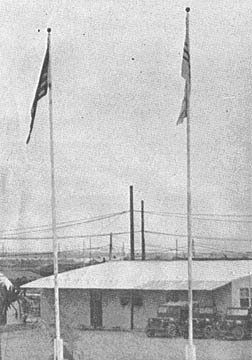 |
ONE YEAR OLD - Last week was the first anniversary of "Old Glory" flying on the Division's flagpole in front of headquarters. (US Army Photo) |
Page 7 TROPIC LIGHTNING NEWS July 17, 1967
VC Monkey Shines
Monkey business was literally the order of the day for an ambush
patrol from the 2nd Bn, 14th Inf, on an operation in Binh Dong Province, 19 kms
east of Cu Chi.
As the patrol moved through a rice paddy, they spotted a big monkey
watching them from the woodline. The patrol moved on and the monkey soon
appeared again, this time close enough that a frayed rope could be seen hanging
from its neck.
With tongue in cheek, the squad leader radioed his headquarters
that a monkey was following the patrol, diligently keeping it under observation.
After a short pause, the patrol received instructions to watch the monkey
closely because he might be a Viet Cong monkey trained to gather information.
The patrol continued, closely shadowed by the conscientious monkey.
After a while however, the monkey began to get on the men's
nerves, and they threw rocks and fired a few rounds to scare it off.
Apparently they succeeded for the monkey faded back into the undergrowth.
Two hours later, the patrol set up ambush positions, and began
their wait for any unsuspecting VC. Suddenly the monkey reappeared, and
dropped into a foxhole next to a startled soldier. He lunged for the
monkey, but just missed, and the monkey fled through the treetops never to be
seen again.
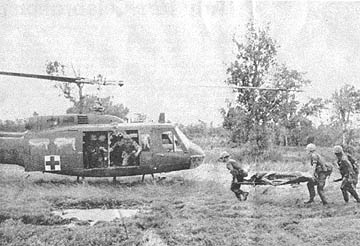 |
A FALLEN COMRADE - Medics carrying a wounded soldier through a rain-soaked rice paddy to a waiting helicopter minutes after his unit, the 2nd Bn, 14th Inf, made contact with an enemy force along the Saigon River in Binh Duong Province, during the 25th Div Operation "Barking Sands". (Photo by PFC Bill Wermine) |
25th S&T-Million Mile Mark
Co B dispatchers of the 25th S&T Bn recently announced that
their drivers had logged over 1,000,000 miles on their trucks.
It all started over a year ago when the unit arrived in Vietnam
with the 25th Inf Div. Since then the "Cu Chi Express" trucks have
been a daily feature on the convoys transferring the tons of supplies from Long
Bien and Saigon to the Cu Chi base camp.
Truck driving is a job which starts early in the morning and ends
only when the trucks are ready for the next day. While on the road there
is always danger involved from the possibility of hitting a mine, receiving
sniper fire, or having a grenade tossed into the truck.
Driving in Saigon traffic also adds to the hazards of the
occupation, so out of necessity the men have developed a unique but unnerving
talent for getting through the embroiling free-for-all.
Though there is some danger, the routes they travel are relatively
secure. But, driving those routes requires a high degree of skill and an
exacting knowledge of the city. Their driving skill accounts for the
extremely low rate of accidents among S&T's drivers as compared to similar
units driving under comparably stressing conditions.
For these men there is little chance for glory. They must
measure their success by the success of the front line soldier.
With this in mind they realize the urgency of their mission and
pursue it in accord with the motto of S&T, "Without Delay."
Sing Along Hoi Chanh
DUC PHO - It's sing-along time as the Quang Ngai cultural-drama
team makes its appearance in the Duc Pho area.
Sponsored by JUSPAO (Joint United States Public Affairs Office),
the troupe travels about the countryside of Quang Ngai Province singing folk
songs of happy Hoi Chanh.
The songs tell of former Viet Cong soldiers who have returned to
the government of Vietnam and are now reunited with their families and enjoying
peaceful and productive lives.
Working closely with American and Vietnamese fighting units, the
cultural-drama team moved into areas known to be VC-infested. They teach
the people their songs and conduct sing-alongs in an effort to win over the
families of VC who in turn will influence Communists hiding in the area.
In addition to stories about former Hoi Chanh, the songs also
include instructions on how to return to the government and the advantages, such
as training programs, available to those who return.
Squad Alerted by Torch
A woman carrying a torch alerted a squad from the 2nd Bn, 14th Inf,
to the position of several Viet Cong.
The Co A squad was walking down a trail at night when the woman was
spotted. The men immediately alerted and continued to move cautiously
along the trail.
After advancing 50 meters, SP4 Michael W. Young of Seattle, Wash.,
noticed movement in the brush ahead. He gave the alarm for the squad to
take cover.
Young carefully advanced toward the brush. When he split the
foliage, a VC jumped out. Quickly Young squeezed the trigger on his M-79
and fired a round at the surprised enemy.
Other VC concealed in the area opened up with claymore mines,
grenades, and automatic weapons.
The Americans returned the fire and the fight went on for about 30
minutes. Finally the Viet Cong fled into the darkness. One dead VC
was found and five more were seen to have dropped during the battle.
Page 8 TROPIC LIGHTNING NEWS July 17, 1967
| A WAITING GAME - Men from the 2nd Bn, 14th Inf, use the protection of a berm in a flooded rice paddy, while an airstrike pounds an enemy position to their front. The contact was made along the Saigon River in Binh Duong Province, 28 Kms north of Saigon, during Operation "Barking Sands." (Photo by PFC Bill Wermine) | 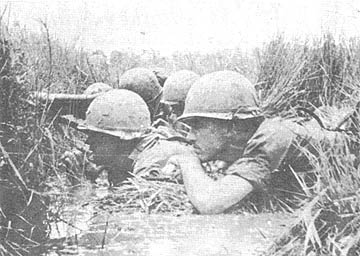 |
LRRP Has Long Sleepless Night
CHU LAI - SGT Michael W. Daniels, Fairfax, Va., of the 196th Lt
Bde's Long Range Reconnaissance Patrol (LRRP) recently led his team on a
three-day recon mission which almost ended the first night.
Daniels and his LRRP team were heliborne to a hill northwest of Chu
Lai to set up a three-day observation post. As the team began the 72 hours
of cautious watching, they heard shots from across the ridge. Another LRRP
team, headed by CPL William Davis of Nitro, W.Va., was on a hill on the other
side of the ridge, and Daniels thought they were trying to signal him.
He had his men fire some rounds in the air to acknowledge the
signal, and then heard more shooting from the other hill. This time it
didn't sound like M-16 rifle fire, and when the men heard M-79, machine gun
and carbine fire join in the chorus, they realized that Davis' team was under
attack.
After several minutes of anxious listening, Daniels and his men saw
the other LRRP team being extracted from their hilltop position by helicopter,
and they breathed a little easier. Daniels' team was on a hilltop and
there was very little cover anywhere. The 1st Bn, 14th Inf, attached to
the 196th, had previously undertaken a search and destroy operation in the area,
and it was known to be heavily populated by Viet Cong.
Daniels' observation team depended for their lives on remaining
hidden from the VC, and they wondered if they had given their position away by
signalling Davis on the other hill. There was nothing to do but sit it out
and hope the Cong attacking Davis had not noticed Daniels' fire.
Soon, though, the worst began to happen. Sniper rounds
started zinging into Daniels' exposed position, from a hillside about 800
meters away. The multi-talented LRRP team quickly called in artillery on
the sniper, and the first rounds were on target.
Knowing that they were in for a long night, the team placed out
trip flares and claymore mines around their defensive position. At about
9:15 that night they observed two flashlights bobbing around where their
insertion chopper had landed, and soon the men with the flashlights began
following the trail Daniels and the team had taken to reach their OP position,
about 500 meters away. "We just watched and held our breath,"
recalled Daniels. "We didn't want to make contact and could only hope
they wouldn't see us in the dark."
The "no contact" rule went out the window in the next few
minutes when PFC Mark Brennan of Burtis Landing, Conn., heard men moving towards
him from less than 50 meters away. Brennan, figuring they had already been
given away and not wanting to risk being seen first, shot off a hand
illumination flare which exposed two VC, who had remained at the bottom of the
hill, opened up on the LRRP with carbines and automatic weapons.
"It sounded like World War III," said Daniels, "but they were
too close to our position for us to get help from the artillery."
A group of VC was sneaking up a draw to the hilltop, but were
spotted by the team's machine gunners, PFC William Conner of Rahway, N.J., who
ran 50 meters through criss-crossing tracers and blasted the maneuvering enemy
with his M-60. Another element was coming up the other side of the hill,
and the rest of the LRRP men concentrated on that group.
Daniels, meanwhile, was calling for helicopter gunships from Task
Force Oregon, and he soon got help. Two "Firebirds" from the 161st Avn
company answered the call with machine guns and blazing rockets, working over
the sides and bottom of the hill on repeated passes. The VC weren't
giving up, as became evident when ground fire hit a machine gun on one of the
choppers. Knocked half off its mount, the gun went wild and sprayed a
stream of tracers over the hilltop and into the LRRP's position. None of
Daniels' men were hit.
The now-retreating VC received a parting shot when Daniels called
in artillery. Illumination rounds from the guns enabled the LRRP team to
direct the deadly high explosives on the enemy, which split into small groups of
two or three and made frantically for the woods.
The LRRP team quickly moved to another side of the hilltop, hoping
to confuse any more probes by "Victor Charlie". It was a good move.
Later in the night the men heard whispered talk on the hillside and, soon after,
on the hilltop itself. Not wanting another encounter with the large force,
each man held his breath and lay completely silent.
Their silence payed off, and the probing element finally decided
the Americans must have left. The VC finally did the same, but none of the
recondos got any sleep that night.
Arty Has Celebration
A pig and 155mm howitzer shells each in their own way provided C
Btry, 3rd Bn, 13th Arty, with a lively Fourth of July celebration.
The men of Charlie Btry had spent long months in the field and
vowed to have a celebration when they finally returned to their base camp at Cu
Chi. They hoped to be back from the field by Independence Day and set
tentative plans to hold a Bar-B-Q on the fourth.
On the 15th of May a piglet was bought in Cu Chi by 2LT William J.
Long of Las Cruces, N.M. The artillerymen intended to fatten him up and
roast him over a slow fire to provide a superb meal reminiscent of feasts held
during Revolutionary War times.
The shoat was given the rather dubious name of Oscar and as he
grew, so grew a vexing problem. What do you do with a pig in the Army?
"The first problem of where to keep him was solved by carrying
him in the back of a five ton truck," said SP4 Richard M. Snyder of
Grandhaven, Michigan. "He went darn near every place we did!" laughed
Snyder. So Oscar, the pet porker, became a familiar sight in many fire
bases as he squealed, squawled and generally caused havoc in the battery area.
SSG Thomas McIntyre of Morgantown, W. Va., recalled one time when
Oscar took to running around a little airstrip at Go Dau Ha, driving many pilots
and officers to distraction with his antics. Suggestions and threats flew
thick and fast that the pig be shot, stabbed, or blown up, but the cannoneers
zealously protected Oscar and taught him to stay away from strange men with
bayonets.
One of the most difficult problems encountered was locating a
source of food for the pig but with typical Army ingenuity a suitable menu was
arranged.
"We fed him on a diet of beer and corn flakes" stated Long.
"One time we returned from a road march with some rusty cans of beer that
nobody wanted to drink, so we mixed eight cans of beer with his corn flakes that
day. Poor Oscar was so smashed he could hardly move," chuckled Long.
Oscar was beginning to become a pet but that was only temporary
because he had a very obnoxious attitude if he wasn't fed on time. His
habit of sneaking into the tents and nuzzling sleepy soldiers with his moist
snout "endeared" him to everyone.
On the day of the Bar-B-Q Oscar was roasted for an evening meal
while the Red Legs feasted throughout the day on charcoal broiled steaks, pizza,
and shishkabob. The high point of the celebration was the roast pork which
had a wonderful flavor.
As if to complete the day, several Viet Cong were spotted by
helicopter and a radio message was called into Charlie Btry asking for
artillery. The resulting fire mission netted seven possible VC killed and
an explosive end to the festivities.
Black Barons
The official records in the Department of the Army show that the
Headquarters and Headquarters detachment of the 269th Cbt Avn Bn was first
placed on the rolls of the Army on the 7th of April 1966. The battalion
wasn't activated until July 1, 1966. The new unit formed at Ft Bragg,
N.C., for deployment to Vietnam.
On Jan. 6, 1967, the "Black Barons" departed for Vietnam.
At the end of January, the unit saw its "New Home" for the first time.
The designation Black Barons was selected in honor of LTC Roger
Waterbury, the battalion operations officer upon its arrival in Vietnam, and the
first battle casualty suffered by the battalion headquarters.
The unit's history is a proud one. In combat support of
allied ground forces in Vietnam, the battalion's helicopters have flown 64,477
sorties in 26,256 flying hours. Since the Black Barons became operational
on March 19, 1966, they have carried 110,727 passengers and 4371 tons of cargo.
The Barons have killed 210 enemy, detained 22 suspects, and destroyed 108
structures.
Under its current commander, LTC James H. Merryman, of Arlington,
Va., the battalion has three helicopter companies and one Bird-Dog company.
On the occasion of its anniversary in July, LTC Merryman said: "The Black
Barons have established an enviable record of progress in the concept of U.S.
Army air mobility."
VC Tunnels Uncovered
Thanks to
First Sergeant O.N. Davisson, 25th Aviation Bn. for sharing this issue,
Ron Leonard, 25th Aviation Bn. for locating and mailing the issue,
Kirk Ramsey, 2nd Bn., 14th Inf. for creating this page.
This page last modified 8-12-2004
©2004 25th Infantry Division Association. All rights reserved.